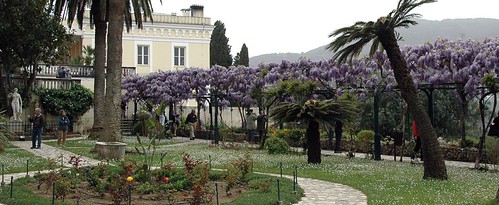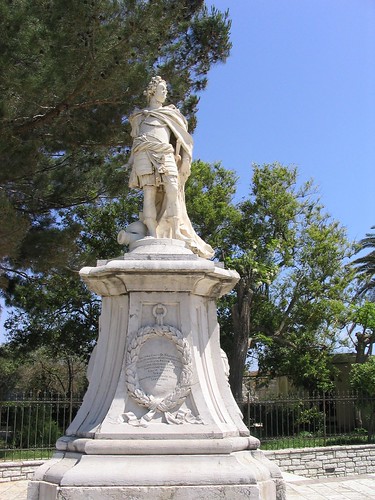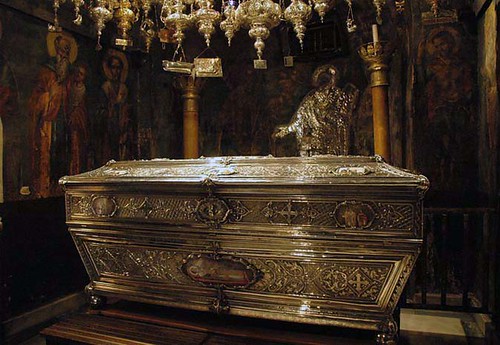Monday, April 13, 2009
Last night I slept like a lump of dough in a bread machine. That I didn’t need. This morning I woke up to see bird droppings on my cabin window. In the bathroom I noticed that the brand of tissues is called Funny. I wonder if the other cabins have the same brand or if someone is trying to send me a message. I make for the library first thing to update my blog. The room looks like Savonarola had been preparing for a book burning. And now, in preparation for Albania, Paul Harris gives us a picture of the country. Allan Langsdale follows with a talk on Basillicas and Baptistries at Butrint.
Unfortunately, we won’t be able to put what either has taught us to the test. It seems that the ship is being stalked by a low-pressure system. The upshot of that bad behavior is that, since all the harbors in Albania open to the southeast, the ship could make it into harbor but not out. The staff and Captain have come up with a Plan B. We detour to the Greek island of Corfu. Lia and her staff have managed to arrange a whole new itinerary in a few hours. When we dock, three busses and a contingent of guides are ready to take us to see the Achilleion Palace, the Church of St. Spiridon, an overlook with views of Ptichia and Mouse islands, with time to spare for a walk through Corfu town. At the overlook the wind is so strong it is an effort to face it.
Elizabeth of Austria was Franz Josef’s wife. He, however, preferred an actress. So Sissi, as she was called, built Achilleion and retreated there as often as she could until she was stabbed to death in Geneva where she was staying on a private visit. Her last words were “What happened to me?”
Several years later Kaiser Wilhelm II bought Achilleion. In one of the rooms his writing desk is on display. For a seat it had a saddle instead of a chair. Apparently, he loved riding, even when he was writing.
I am not very fond of Kings and Queens. So it is hard for me to break through a certain democratic antipathy toward the luxury of the place, as low key as it is, compared, say, to Versailles. Furthermore, the photographs of Kaiser Wilhelm standing ramrod straight with his arched back and his Fuller brush moustache, hand resting lightly on sword hilt, are infuriating. Wilhelm wanted war. The assassination of Archduke Ferdinand at Sarajevo was for him what weapons of mass destruction were for George W. Bush.
At one end of the wisteria garden outside the Achilleion Palace there is a statue of Achilles triumphant. At the other end there is the fallen Achillles. The lesson of the two statues is crystal clear. But military power is an aphrodisiac that is hard to resist.

Like so many of the islands of the Aegean, Corfu has been conquered more times than you can shake a stick at, the Romans, the Arabs, the Normans, the Italians, the British. What is conspicuously missing from the list is, of course, the Ottomans. They have never managed to conquer Corfu though not for want of trying.
In the esplanade where we disembarked for a stroll through Corfu town, there is a statue to Marschal Mattias Johann von der Schulenberg who, in 1716, repulsed the last attack of the Ottoman Turks against Corfu. Sultan Ahmet III had ordered a force of 30,000 men and 3,000 horse to breech the citadel that stands opposite the esplanade.
The siege lasted five months. Finally, on August 18 von Schulenberg with 800 picked men launched a surprise counter-attack, creeping out of the citadal just before dawn and attacking the Turks from the rear. The maneuver was a success and also incredibly well timed. The next day a horrific storm broke that not only tore the Turkish tents to shreds and reduced their battleground to a mud hole, but destroyed several of their ships in the harbor. The Turks fled. One year almost to the day a bolt of lightning hit the same citadel. It ignited three ammunition stores. The explosion did what the Turks had so miserably failed to do. It was too late. The Turks never conquered Corfu.
During our tour of Corfu Town, we visit the Church of Saint Spyridon, named after the beloved miracle-working patron saint of the island, whose mummified body is enshrined in a silver coffin housed in a tiny room off the main interior of the church. Several days a year, the coffin is opened to allow the faithful to kiss his slipper-clad feet.
As we drive back to the ship, we pass a row of car ferries ready to take cars and their drivers to Greece and points beyond. Their bows are open wide and resting on the quay like so many sheep dogs with their tongues hanging out.


